The Future of HVAC Industry: Emerging Technologies and Sustainable Solutions
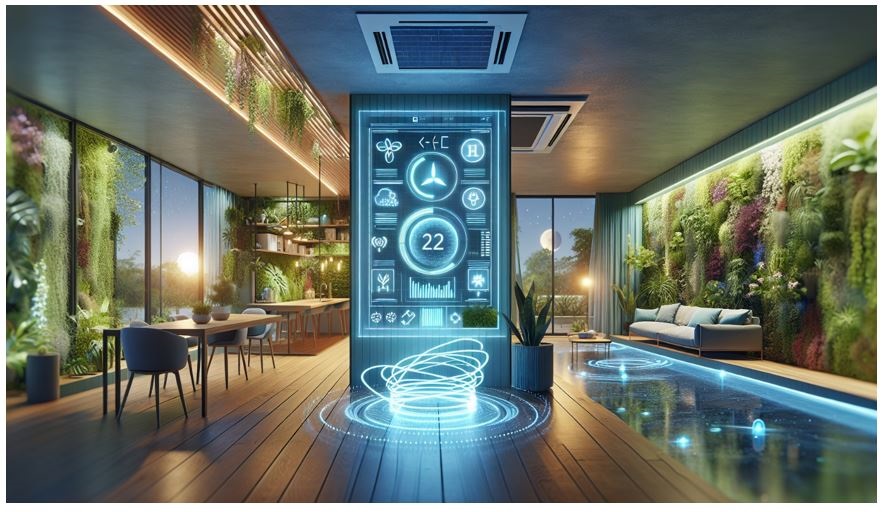
The future of the HVAC industry is rapidly evolving, driven by technological advancements and a growing focus on sustainability. As we approach 2024, the sector is witnessing groundbreaking changes that are reshaping how we think about heating, ventilation, and air conditioning. Energy efficiency has become a top priority, with innovative solutions like variable refrigerant flow systems gaining traction in the market.
Smart HVAC technologies are at the forefront of this transformation, offering unprecedented control and optimization of indoor environments. These systems are not only improving comfort but also contributing to the development of sustainable buildings. From cutting-edge materials to health-centric designs, the HVAC industry is adapting to meet the demands of a more environmentally conscious world. This article explores the emerging trends and technologies that are set to define the future of HVAC, highlighting the industry's move towards more efficient, intelligent, and eco-friendly solutions.
Smart HVAC Systems: The Internet of Things Revolution
The Internet of Things (IoT) is transforming the HVAC industry, ushering in a new era of efficiency and control. This revolution is reshaping how heating, ventilation, and air conditioning systems are managed in both residential and commercial settings. According to Zion Market Research, the global smart HVAC control market is projected to reach USD 28.30 billion by 2025, highlighting the significant impact of IoT on the industry.
Sensors and Data Analytics
At the heart of smart HVAC systems are advanced sensors and data analytics. These technologies work together to gather and interpret crucial information about system performance. IoT-enabled sensors continuously collect real-time data on various parameters such as temperature, humidity, airflow, and energy consumption. This data is then sent to cloud-based platforms for analysis.
Smart algorithms process this information, enabling the system to detect anomalies and predict potential issues before they escalate into major problems. For instance, sensors can identify subtle changes in electrical current or vibrations that might indicate an unbalanced fan or a failing component. This level of detail allows for a more nuanced understanding of the HVAC system's health and performance.
Remote Monitoring and Control
One of the most significant advantages of IoT in HVAC systems is the ability to monitor and control equipment remotely. Facility managers and HVAC contractors can access real-time data and system status through smartphone apps or web portals. This capability enables them to:
- Assess system performance without on-site visits
- Receive instant alerts about potential issues
- Make adjustments to optimize energy efficiency
- Respond quickly to changes in occupancy or weather conditions
Remote monitoring also allows for more effective energy management. By analyzing usage trends and even incorporating weather predictions, smart HVAC systems can regulate indoor climate more efficiently, keeping power consumption to a minimum.
Predictive Maintenance
Predictive maintenance is perhaps the most transformative aspect of IoT in HVAC systems. Traditional maintenance approaches often rely on scheduled check-ups or reactive repairs when problems occur. In contrast, predictive maintenance uses data analytics and machine learning to anticipate issues before they lead to system failures.
This proactive approach offers several benefits:
- Reduced downtime and fewer emergency repairs
- Extended equipment lifespan
- Lower maintenance costs
- Improved system reliability and performance
For example, if the system detects that coolant pressure is lower than usual, it can alert technicians to a potential leak or blockage. This early warning allows for timely intervention, preventing more significant damage and maintaining the system's efficiency.
The integration of IoT in HVAC systems is not just a technological advancement; it's a paradigm shift in how we approach climate control and energy management in buildings. As these technologies continue to evolve, we can expect even greater improvements in efficiency, comfort, and sustainability in the HVAC industry.
Energy Efficiency and Sustainability in HVAC
The HVAC industry is undergoing a significant transformation, driven by the urgent need for sustainable solutions and technological advancements in climate control. This shift is particularly evident in the commercial sector, where the focus on energy efficiency and sustainability has become paramount.
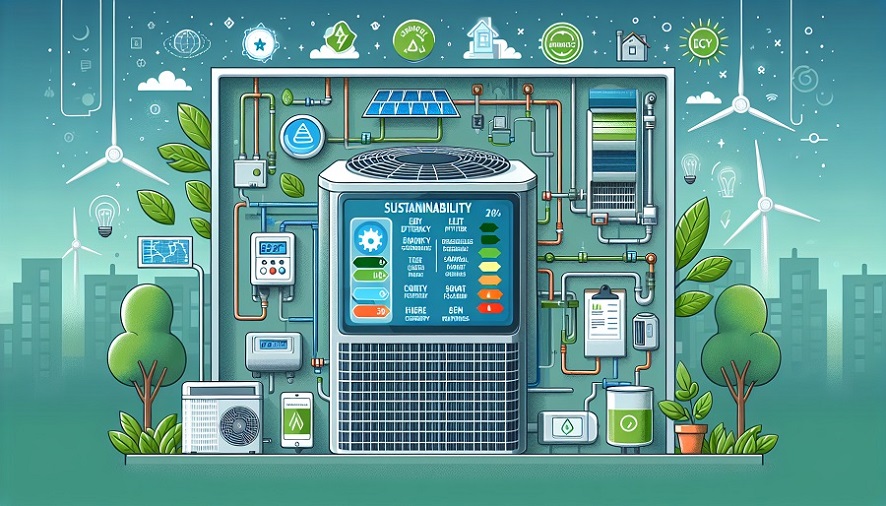
High-Efficiency HVAC Equipment
The quest for energy efficiency has led to the development of high-performance HVAC systems that can significantly reduce energy consumption. According to the U.S. Department of Energy's eeCompass guide, replacing heating and cooling equipment with higher efficiency models can cut energy use by up to 50% for electric systems and 10% for gas furnace heating systems. ENERGY STAR certified equipment, when properly installed, can yield annual energy bill savings of 10-30%.
One notable innovation is the air-source heat pump (ASHP), which has gained popularity in cold climates. However, traditional sizing and installation practices often lead to system inefficiencies. To address this, the industry is developing new guidelines to optimize ASHP performance in challenging environments.
Green Refrigerants
The adoption of eco-friendly refrigerants is a crucial step in combating rising global temperatures. The industry is moving away from ozone-depleting substances towards refrigerants with low Global Warming Potential (GWP). Natural refrigerants like ammonia and CO2 are gaining traction due to their minimal environmental impact.
Ammonia, in particular, stands out for its efficiency and eco-friendliness. It has a latent heat capacity five to six times greater than synthetic refrigerants, making it highly efficient for large-scale applications. Moreover, ammonia systems can achieve temperatures as low as -60°C while consuming significantly less power than traditional systems.
Renewable Energy Integration
Integrating renewable energy sources into HVAC operations is becoming increasingly common, offering both environmental and economic benefits. Solar-powered HVAC systems, for instance, convert sunlight into energy for heating, cooling, and ventilation. These systems not only reduce operational costs but also extend the lifespan of HVAC equipment and improve air quality.
Geothermal HVAC systems tap into the earth's stable temperature, using a network of underground pipes to exchange heat with the ground. This approach significantly enhances energy efficiency and reduces reliance on traditional energy sources.
The integration of smart technology with renewable HVAC systems further optimizes energy use. Programmable thermostats and demand response systems allow for precise control over heating and cooling schedules, minimizing waste and maximizing efficiency.
Indoor Air Quality and Health-Centric HVAC Design
The focus on indoor air quality (IAQ) has become paramount in HVAC design, especially considering that people spend nearly 90% of their time indoors. The U.S. Environmental Protection Agency and the American Lung Association report that indoor air can be up to ten times more polluted than outdoor air, highlighting the critical need for effective air purification in buildings.
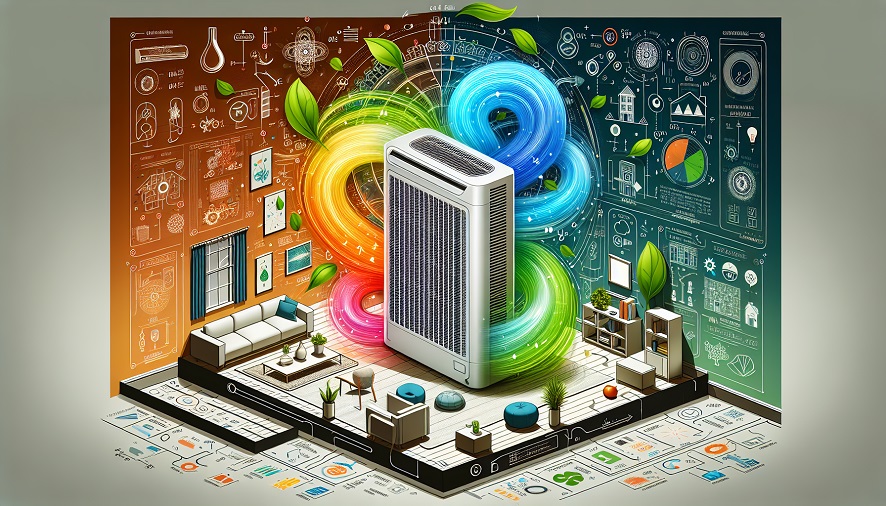
Advanced Filtration Systems
Modern HVAC systems incorporate advanced filtration technologies to combat airborne pollutants. High-Efficiency Particulate Air (HEPA) filters have gained popularity for their ability to trap 99.97% of particles that are 0.3 microns or larger. These filters are particularly effective against dust, pollen, and other allergens, making them ideal for maintaining clean indoor environments.
Activated carbon filters offer a complementary solution, specifically targeting gasses and odors. While not as effective against particulate matter, they excel in removing volatile organic compounds (VOCs) and unpleasant smells from the air. For comprehensive air purification, multi-stage filtration systems combine various technologies, such as pre-filters for large particles, HEPA filters for smaller allergens, and activated carbon for odors and VOCs.
UV-C Germicidal Irradiation
Ultraviolet Germicidal Irradiation (UVGI) has emerged as a powerful tool in the fight against airborne pathogens. UV-C energy, with its shorter wavelengths compared to UV-A and UV-B rays, effectively kills viral, bacterial, and fungal organisms. Upper-room UVGI systems create a disinfection zone above occupied spaces, neutralizing airborne pathogens as they circulate through the room.
These systems are particularly beneficial in high-risk indoor settings, such as healthcare facilities, crowded spaces, and areas where masks must be removed. UVGI has shown promise in controlling SARS-CoV-2, with research indicating that the virus responds similarly to other coronaviruses in terms of UV dose required for inactivation.
Proper ventilation plays a crucial role in maintaining good indoor air quality. The ASHRAE Standard 62.1-2010 establishes minimum ventilation rates to achieve acceptable IAQ through dilution of indoor contaminants with outdoor air. Tools like Carrier's Hourly Analysis Program (HAP) help designers determine optimal ventilation requirements at both space and system levels.
Mechanical ventilation systems, when properly designed, can significantly improve air quality by bringing in filtered outdoor air while removing stale indoor air. Energy recovery ventilators (ERVs) offer an energy-efficient solution, exchanging indoor air with filtered outdoor air while maintaining temperature control.
In conclusion, the integration of advanced filtration, UV-C technology, and optimized ventilation systems represents a holistic approach to health-centric HVAC design. These technologies work in concert to create safer, more comfortable indoor environments, ultimately contributing to improved occupant health and productivity.
Sustainable Cooling Technologies
The HVAC industry is witnessing a significant shift towards sustainable cooling technologies that offer energy efficiency and reduced environmental impact. These innovative solutions are revolutionizing the way buildings are cooled, providing eco-friendly alternatives to traditional air conditioning systems.
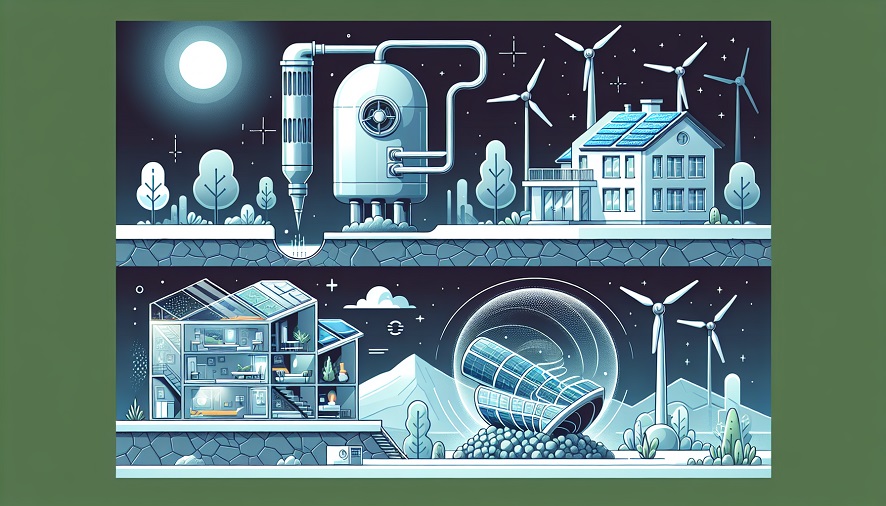
Solar-Powered Air Conditioning
Solar-powered air conditioning systems harness the sun's energy to provide cooling, offering a sustainable solution to rising energy costs. These systems consist of solar panels, an inverter, and an air conditioner. The solar panels convert sunlight into direct current (DC) electricity, which is then transformed into alternating current (AC) by the inverter to power the air conditioner.
One of the primary advantages of solar-powered air conditioning is the potential for significant energy bill reductions. By utilizing free and abundant solar energy, property owners can decrease their reliance on grid electricity for cooling purposes. Additionally, these systems contribute to a cleaner environment by reducing carbon emissions associated with traditional cooling methods.
Solar-powered air conditioning systems can operate effectively even in less sunny climates, albeit with slightly reduced efficiency. To ensure continuous operation during cloudy periods or at night, some systems incorporate battery storage capabilities, allowing for energy storage and use when sunlight is limited.
Geothermal HVAC Systems
Ground-source heat pumps, also known as geothermal HVAC systems, utilize the earth's stable temperature to regulate indoor environments. These systems can be installed in various property types, with options for horizontal or vertical ground loops depending on available space and soil conditions.
Geothermal systems offer impressive energy efficiency, with the potential to reduce heating costs by up to 70% and cooling costs by up to 50% compared to traditional HVAC systems. Their efficiency stems from the ability to transfer heat rather than generate it, resulting in over 400% efficiency in some cases.
|
Aspect |
Geothermal HVAC Performance |
|
Heating Cost Reduction |
Up to 70% |
|
Cooling Cost Reduction |
Up to 50% |
|
Efficiency |
Over 400% possible |
|
Lifespan of Ground Loops |
50+ years |
While the initial installation costs for geothermal systems can be higher than conventional HVAC systems, various incentives and rebates are available to offset these expenses. The U.S. federal government offers a 30% tax credit on the total installed cost of ground source heat pump systems, making them more financially attractive for homeowners.
Ice-Based Thermal Energy Storage
Ice-based thermal energy storage systems present an innovative approach to managing cooling loads and reducing peak energy demand. These systems operate by creating ice during off-peak hours when electricity rates are lower, and then using the stored cooling capacity during peak demand periods.
The concept of thermal ice storage dates back to the 1930s when dairy farmers used it to cool milk efficiently. Today, this technology has evolved to serve various applications, including comfort cooling in large buildings, process cooling in industries, and even improving the efficiency of power generation turbines.
Ice storage systems offer several benefits:
- Reduced on-peak electric demand
- Lower operating costs due to off-peak electricity rates
- Smaller chiller sizes compared to conventional systems
- Ability to provide cooling during power outages or maintenance periods
These sustainable cooling technologies represent a significant step forward in the HVAC industry's efforts to improve energy efficiency and reduce environmental impact. As the demand for eco-friendly solutions continues to grow, these innovations are likely to play an increasingly important role in shaping the future of cooling systems.
The Future of HVAC in Smart Buildings
The future of HVAC systems in smart buildings is characterized by seamless integration, enhanced efficiency, and improved occupant comfort. As buildings become more intelligent, HVAC systems are evolving to play a central role in creating sustainable, comfortable, and productive environments.
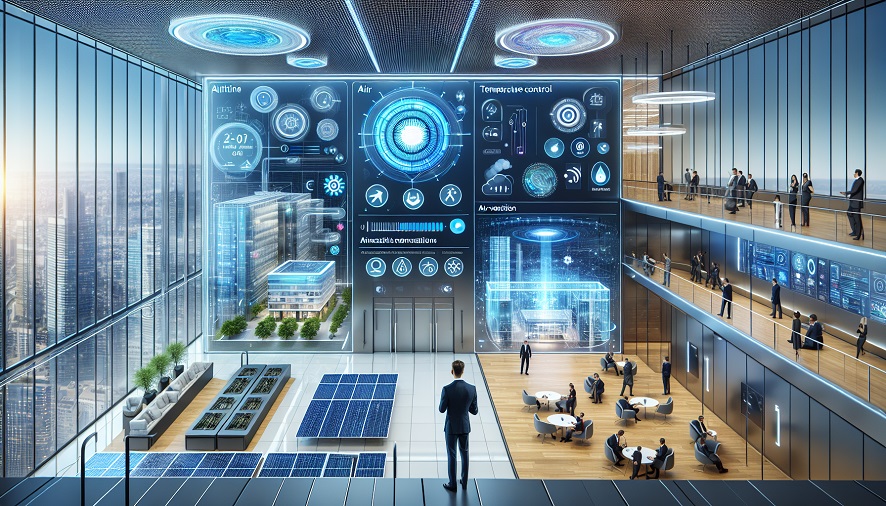
Building Automation Systems
Building Automation Systems (BAS) are revolutionizing the way HVAC systems operate in smart buildings. These systems allow operators to access, control, and monitor all connected building systems from a single interface. By integrating historically siloed systems such as HVAC, lighting, power, and access control, BAS streamlines decision-making and saves time. This centralized control enables informed decisions about reducing energy waste without compromising comfort. For example, when rooms are unoccupied, lights can be turned off, and HVAC output can be reduced until occupants return.
Occupancy-Based Climate Control
Smart HVAC systems utilize advanced sensors and IoT technology to implement occupancy-based climate control. These systems gather environmental data such as temperature, humidity, presence of people, and carbon dioxide levels. Combined with sophisticated control systems, they can precisely manage indoor conditions based on occupancy levels and external weather conditions. This approach not only enhances comfort but also significantly improves energy efficiency by adapting to real-time conditions.
Integration with Other Building Systems
The integration of HVAC systems with other building management systems is a key feature of smart buildings. This holistic approach allows for cohesive control of various building functions, including lighting and security. By working in tandem with other systems, HVAC can contribute to overall building efficiency and sustainability goals. For instance, integrated systems can utilize renewable energy sources like solar and geothermal, reducing dependence on fossil fuels and lowering greenhouse gas emissions.
Innovations in HVAC Materials and Design
3D Printing in HVAC Manufacturing
The HVAC industry is experiencing a revolution with the advent of 3D printing technology. This innovative approach, also known as additive manufacturing, is transforming the production of HVAC components and systems. 3D printing allows for the creation of complex geometries and optimized designs that were previously impossible with traditional manufacturing methods. For instance, heat exchangers can now be produced as a single, continuous piece using materials like titanium or plastic, resulting in improved efficiency and performance.
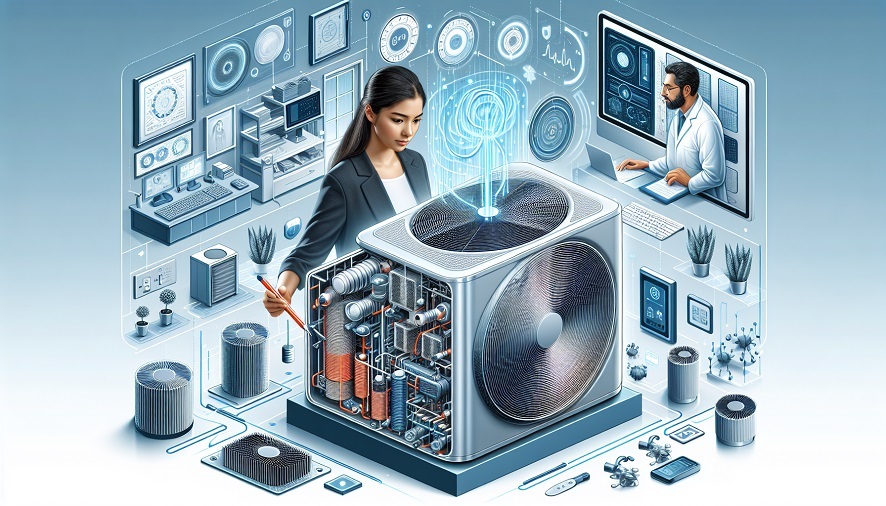
Phase Change Materials (PCMs) represent a groundbreaking innovation in HVAC technology. These materials can absorb and release large amounts of thermal energy during phase transitions, effectively acting as thermal batteries. PCMs can be integrated into building materials such as ceilings, floors, and even windows, helping to flatten heat load peaks and reduce the size and energy consumption of cooling systems. This technology has the potential to significantly improve energy efficiency and provide more stable indoor temperatures.
Modular and Scalable HVAC Systems
The future of HVAC design is moving towards modular and scalable systems that can adapt to changing needs. These systems are designed with flexibility in mind, allowing for easy expansion or modification as building requirements evolve. Modular HVAC units can be quickly installed and integrated into a building's ductwork, offering significant time and cost savings during construction. Moreover, scalable systems ensure that HVAC capacity can be adjusted to match the actual needs of a space, improving energy efficiency and reducing operational costs.
FAQs
What advancements are expected in HVAC technology in the near future?
Future HVAC systems will incorporate advanced technologies like geothermal heat pumps, solar power, smart thermostats, and ice-powered air conditioning. These innovations aim to reduce energy consumption and minimize environmental impact.
How can HVAC systems become more sustainable?
One sustainable option for HVAC systems is utilizing solar power. Solar-powered HVAC systems convert solar energy into electricity to operate heating and cooling components, thereby reducing reliance on conventional power grids and enhancing environmental sustainability.
What is the projected market growth for HVAC systems by 2028?
The global HVAC market, valued at USD 281.7 billion in 2024, is expected to expand to USD 389.9 billion by 2029. This growth, at a compound annual growth rate (CAGR) of 6.7%, is influenced by factors including the COVID-19 pandemic and geopolitical events like the Russia-Ukraine conflict.
What are the emerging HVAC technologies anticipated by 2024?
By 2024, significant advancements in HVAC technology are expected to include solar thermal and geothermal heat pumps. Solar thermal systems collect and convert solar energy into heat, while geothermal systems use the earth's stable temperatures to efficiently heat and cool buildings.
Related Reports:
HVAC System Market by Cooling (Unitary Air Conditioner, VRF), Heating (Heat Pump, Furnace), Ventilation (AHU, Air Filter), Service Type (Installation, Maintenance & Repair), Implementation Type (New Construction, Retrofit) - Global Forecast to 2029
Contact:
Mr. Rohan Salgarkar
MarketsandMarkets™ INC.
1615 South Congress Ave.
Suite 103
Delray Beach, FL 33445
USA : 1-888-600-6441
sales@marketsandmarkets.com
This FREE sample includes market data points, ranging from trend analyses to market estimates & forecasts. See for yourself.
SEND ME A FREE SAMPLE





